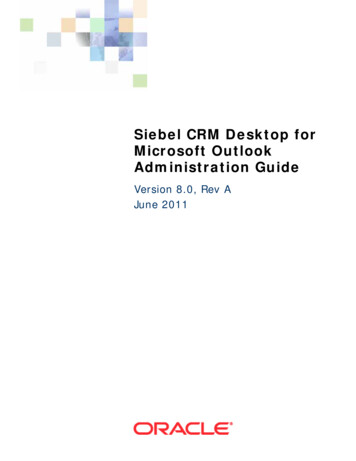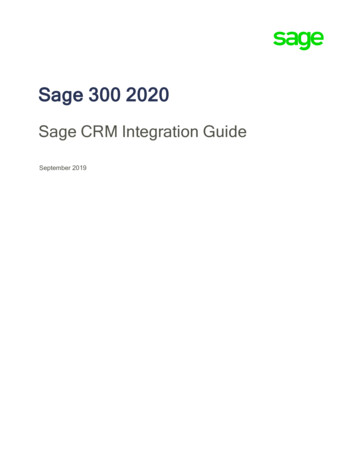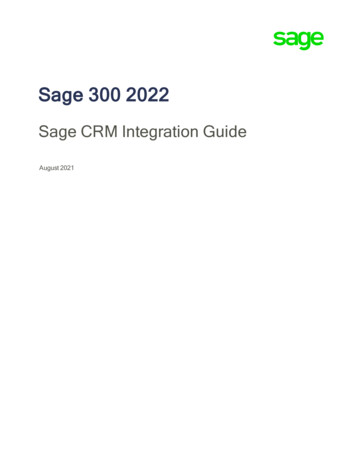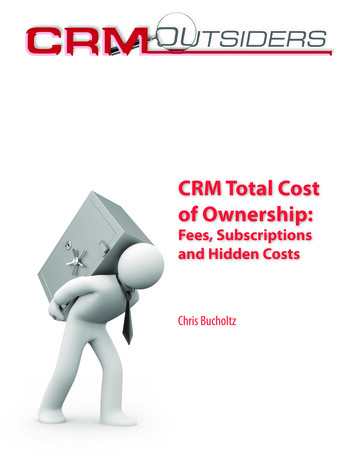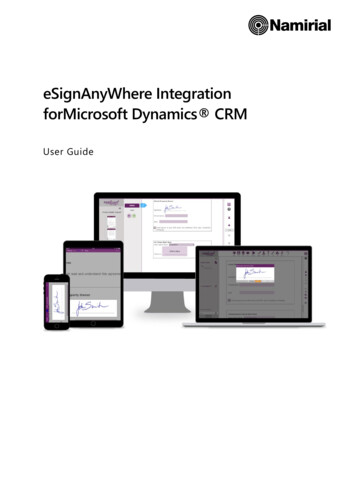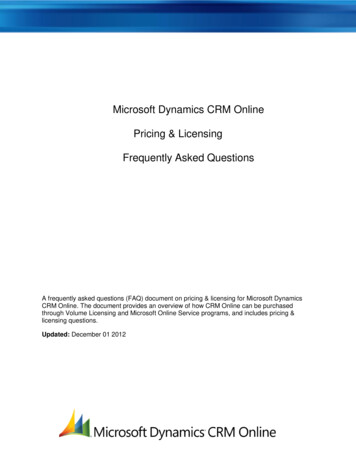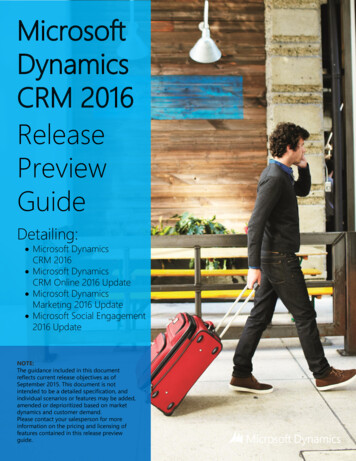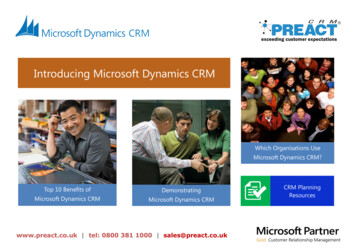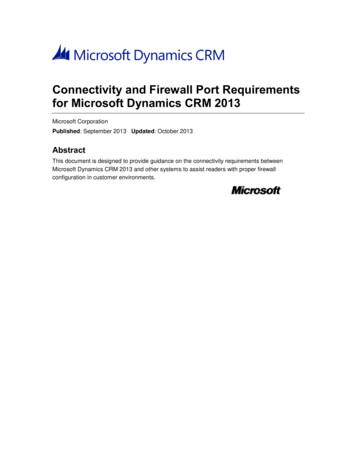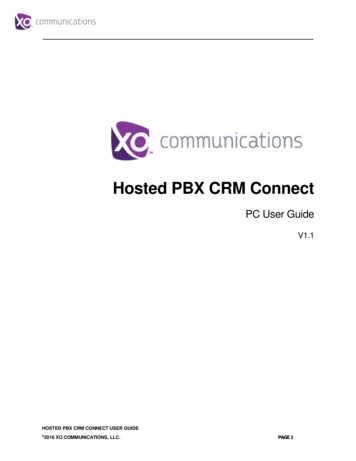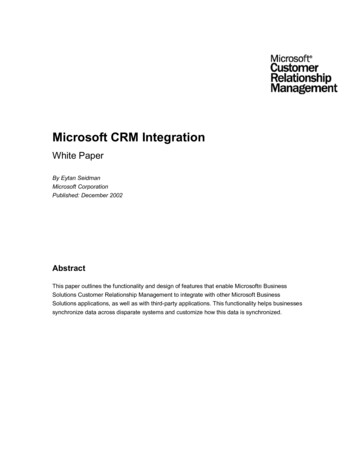
Transcription
Microsoft CRM IntegrationWhite PaperBy Eytan SeidmanMicrosoft CorporationPublished: December 2002AbstractThis paper outlines the functionality and design of features that enable Microsoft BusinessSolutions Customer Relationship Management to integrate with other Microsoft BusinessSolutions applications, as well as with third-party applications. This functionality helps businessessynchronize data across disparate systems and customize how this data is synchronized.
This is a preliminary document and may be changed substantially prior to final commercial release of the software described herein.The information contained in this document represents the current view of Microsoft Corporation on the issues discussed as of the date ofpublication. Because Microsoft must respond to changing market conditions, it should not be interpreted to be a commitment on the part ofMicrosoft, and Microsoft cannot guarantee the accuracy of any information presented after the date of publication.This white paper is for informational purposes only. MICROSOFT MAKES NO WARRANTIES, EXPRESS OR IMPLIED, IN THISDOCUMENT.Complying with all applicable copyright laws is the responsibility of the user. Without limiting the rights under copyright, no part of thisdocument may be reproduced, stored in, or introduced into a retrieval system, or transmitted in any form or by any means (electronic,mechanical, photocopying, recording, or otherwise), or for any purpose, without the express written permission of Microsoft Corporation.Microsoft may have patents, patent applications, trademarks, copyrights, or other intellectual property rights covering subject matter in thisdocument. Except as expressly provided in any written license agreement from Microsoft, the furnishing of this document does not give youany license to these patents, trademarks, copyrights, or other intellectual property. 2002 Microsoft Corporation. All rights reserved.Microsoft, BizTalk, Visual Basic C , Microsoft SQL Server, Visual Basic and Windows are either registered trademarks or trademarks ofMicrosoft Corporation in the United States and/or other countries.The names of actual companies and products mentioned herein may be the trademarks of their respective owners.
ContentsAbstract . iContents .iiiAcknowledgements .ivIntroduction . 1How Microsoft CRM Integration Works . 1Core Integration Service and Customization.2Microsoft CRM Integration architecture .2Publishing data to a message queue.2Receive functions.3Microsoft CRM Integration preprocessor .3Channels and the BizTalk Mapper tool .4Managing changes to the channel .5Pipeline components.6Using application integration components.6Microsoft CRM Integration linking system .7Microsoft CRM Integration – Settings and Administration Tool .7Settings and Administration tool .7BizTalk document tracking .9End-User Experience .9State and status of an integrated entity .9Conclusion . 11Appendix A: Glossary of Technology Terms. 12Appendix B: Overview of Integration Points . 12
AcknowledgementsKevin Whittenberger, Software Design Engineer, Microsoft Corporation
IntroductionMicrosoft Business Solutions Customer Relationship Management (Microsoft CRM) software is aline-of-business application designed to help revolutionize the productivity and total cost of1ownership of CRM applications for the mid-market. Built to deliver an outstanding out-of-thebox experience for customers, Microsoft CRM also gives value-added resellers and independentsoftware vendors a platform for extending the solution.Microsoft CRM Integration is a component of Microsoft CRM and a complete solution forintegrating with Microsoft Business Solutions applications, including Microsoft BusinessSolutions—Great Plains Release 7.0 , Microsoft Business Solutions—Solomon IV Release 5.0,2Microsoft Business Solutions—Navision, and Microsoft Business Solutions—Axapta.This document covers design aspects and features that will help you: Understand how Microsoft CRM Integration uses Microsoft BizTalk Server 2002 Understand the platform upon which Microsoft CRM Integration is built Explore and change settings with the Settings and Administration tool Customize field mappings using Microsoft BizTalk Mapper Learn about the end-user experience on objects that are integrated.How Microsoft CRM Integration WorksThe primary service of Microsoft CRM Integration is to provide ongoing synchronization of databetween Microsoft CRM and Microsoft Business Solutions—Great Plains and Microsoft BusinessSolutions—Solomon. Microsoft CRM Integration also offers the following additional services: A Settings and Administration tool that allows a user to configure settings related to whatdata should be moved between the systems, and that also details particular businesslogic settings. Microsoft BizTalk Server 2002, which allows for rich customization of how data istransformed between the two systems.The Settings and Administration tool offers more functionality than in previous versions of theintegration and does so in a way that is easier for the user. Furthermore, BizTalk Server 2002provides a robust platform for integration with Microsoft Business Solutions applications and tobuild out integrations with other third-party applications.1Mid-market is defined here as companies with between 25 and 1,000 employees.2Microsoft Customer Relationship Management Integration for Great Plains will be released very close to the same time as the release ofMicrosoft CRM . Integration with Solomon, Navision, and Axapta will follow.Microsoft CRM Integration 1
Core Integration Service and CustomizationMicrosoft CRM Integration architectureMicrosoft CRM Integration is built on top of Microsoft BizTalk Server 2002 Partner Edition.Microsoft CRM Integration supports the synchronization of data between business applications byproviding the following: Components that can publish data out of the line-of-business application based onparameters, such as whether the entity has been updated A mechanism that provides for guaranteed delivery of messages between the twosystems A mechanism for transforming data and adding necessary business logic.MessageQueuingReceiveFunctionsGreat PlainsMicrosoft CRMChannelBTS Mapper ToolGreat elineComponentMicrosoftCRM BizTalkServerAdapterBizTalk Server (BTS).Figure 1. A High-level view of Microsoft CRM Integration architecture.Publishing data to a message queueThe process begins when an event occurs in one of the two systems. For example, after anaccount has been created, Microsoft CRM uses its metadata to know the event should beMicrosoft CRM Integration 2
recognized and transmits that data to a specified location. Microsoft CRM Integration thenpublishes the data to the Microsoft Message Queue (MSMQ); however, the data could bepublished to other systems, such as the file system. Microsoft CRM only publishes those fieldsthat have been changed. That is, if a user updates only the account name on an account, thenonly the account name will be sent. The data is sent out as a message in Extensible Markup3Language (XML) format, specifically in XML-Data Reduced (XDR) format.To publish data out of Microsoft Business Solutions—Great Plains, a slightly different mechanismis used. The mechanism will be referred to broadly as Document Exchange (DX). DX iscomposed of Microsoft SQL Server triggers and Microsoft SQL Server Data TransformationServices (DTS) packages. To understand how data moves out of Microsoft Business Solutions-Great Plains, consider the following description of a single update to a customer record:1. A user updates a customer record.2. A Microsoft SQL Server trigger takes the data from the customer record and inserts thekey data into the shadow table.3. A DX package runs according to schedule and moves the key data from the shadowtable to the work table using a stored procedure.4. A DX package runs another stored procedure that looks for all of the necessary data thatneeds to be published.5. Once all data that needs to be published has been found, it is placed by DX onto aqueue—specifically, in this case, to MSMQ.In summary, data publishing occurs quite differently in Microsoft Business Solutions—GreatPlains than in Microsoft CRM because of the differing architectures. The result, however, is thesame: Data is published to a message queue.Receive functionsOnce the data has been dropped off onto the queue, Microsoft CRM itself no longer plays a rolein the integration. That is, Microsoft CRM considers the action as “fire and forget.” Microsoft CRMIntegration configures a BizTalk Server receive function upon setup. This receive function is usedto pick up data from various systems. In the case of Microsoft CRM Integration, it will pick up datafrom the queue from which Microsoft CRM has published.Microsoft CRM Integration preprocessorAfter picking up the data off the queue, the Microsoft CRM Integration preprocessor analyzes it.The preprocessor determines whether it needs more data from Microsoft CRM and, if so, queriesfor the necessary records. An example would be the creation of a new account in Microsoft CRM.The account is sent out to MSMQ, where the preprocessor picks up and then examines the data.The preprocessor determines that it needs all of the addresses related to that account and3BizTalk Server 2002 does not yet support Extensible Structure Definition (XSD) format. Once BizTalk Server supports XSD, MicrosoftCRM Application Integration will as well.Microsoft CRM Integration 3
queries back into Microsoft CRM for all of the addresses. Once all information has been obtainedby the system, the message is sent by BizTalk Messaging Services to all appropriate channels.(For definitions of BizTalk Server Channels, see Appendix A.) Each channel determines whatinbound document it has received and, subsequently, which map to apply and what outbounddocument it will transform into. Once the transformed outbound document has been created, it isthen sent to the appropriate application integration component (AIC).Channels and the BizTalk Mapper toolBizTalk Channels are the heart of Microsoft CRM Integration. Channels are crucial to theintegration, because it is within the channel that much of the transformation occurs. A channel isdefined by three pieces of information: one inbound document (an XML file), one outbounddocument (also an XML file), and a XSL file map that dictates how the inbound document istransformed into the outbound document. By using the BizTalk Mapper, a developer can makemodifications to existing mappings or introduce new mappings to fields that are not mapped outof the box. Creating new mappings between custom fields in Microsoft CRM and user-definedfields in Microsoft Business Solutions—Great Plains is supported without any caveats. Makingadditional changes to existing modifications is allowed, but with extra support from MicrosoftBusiness Solutions to ensure that the integrity of the system will not be compromised by makingsuch modifications.The BizTalk Mapper has been designed to help support complex structural transformations fromrecords and fields in the source specification tree (either Microsoft CRM or Microsoft BusinessSolutions—Great Plains) to records and fields in the destination specification tree. Because ofthis support capacity, BizTalk Mapper is an ideal tool for customizing the integration betweenMicrosoft CRM and Microsoft Business Solutions—Great Plains. It allows a developer to writelogic easily about how data in the source specification should be transformed to data in thedestination specification. The core mechanism for performing these transformations is called afunctoid.A functoid is a predefined formula that takes in arguments and then performs specificcalculations. For example, BizTalk Mapper provides an Addition functoid that takes the values ofdesignated fields on the source side and then outputs the result to a field on the destination side.Because not all possible data transformations can be done using the predefined functoids thatMicrosoft BizTalk Server 2002 provides, there is also a way to create custom functoids. To usecustom functoids, simply use the Scripting functoid on the Advanced palette. Custom functoidscan be written either in Microsoft Visual Basic Scripting Edition (VBScript) or Microsoft JScript.The following VBScript code helps produce the mapping between a Microsoft CRM accountaddress and a customer address in Microsoft Business Solutions—Great Plains:1. Function SetActionValue( Action, EmptyValues, SourceSystemID,SourceEntityID, MessageId, Required )2. Dim retValue, sExistingLinkMicrosoft CRM Integration 4
3. If LCase(Action) "ignore" Then4. retValue "ignore"5. Else6. sExistingLink MSCRMObj.GetDestinationLink( SourceSystemID,gSourceEntityType, SourceEntityID, MessageId, gChannelName,gDestSystem, gDestObjectType, Required )7. If trim(sExistingLink) "" Then8. sExistingLink "false"9. Else10. sExistingLink "true"11. End If12. End FunctionThe first line of code establishes the function name and the parameters that it is taking in. In thiscase, the parameters come from the header of the XML message. The second line declares twovariables that are going to be used in the function. The third line of code checks to determine ifthe action is “ignore”; if it is, then the code stops here. In line 6, the code tries the other branchbecause the action is not set to ignore.In working with line 6 of the code, developers can use BizTalk Server to leverage the code thatalready exists within the Microsoft CRM Integration platform. The object called MSCRMObjactually has been instantiated previously and then reused here. The method GetDestinationLinkis actually in a method in the dynamic-link library (DLL) called XSLUtility. The remaining codelines (7-11) decipher the return value of the method and set the variable of sExistingLink to trueor false, based on the return value.Once you make modifications to a map using BizTalk Mapper, it is important to verify that the newmap is syntactically correct. To do so, you can use the compile feature, which will take the mapthat the developer has created and enforce the structural rules and transformations that are in themapping grid.In summary, the BizTalk Mapper tool enables developers to write highly customizedtransformations between Microsoft CRM and Microsoft Business Solutions—Great Plains.Managing changes to the channelMaps that define data transformation can reside in two places:Microsoft CRM Integration 5
A local hard drive Web Distributed Authoring and Versioning (WebDAV).By default, all maps are published to WebDAV so that BizTalk Messaging Manager can usethem. If, however, you want to customize maps and then test them before actually publishingthem to WebDAV, you can save the customized map to the local hard drive. To customize andtest a map, go into BizTalk Mapper, retrieve a map from WebDAV, and make all of the desiredcustomizations. Then save the map to the local hard drive and test the map there. After testing,you can save the map to WebDAV so it can be used collaboratively.Pipeline componentsAnother integral part of Microsoft CRM Integration is its use of pipeline components. Once thedata has been transformed by the channel, it calls a pipeline component; this component thencommunicates with the AIC. In short, it is the pipeline component, not the BizTalk Server channel,which communicates directly with the AIC.The pipeline component has three major responsibilities inside of the system:1. Responsibility for linking messages together: The pipeline component as detailedbelow is responsible for linking messages together. That is, after a message has beensent to the AIC, the linking mechanism is responsible for persisting the fact that a certainaccount in Microsoft CRM has been linked to a certain customer in Microsoft BusinessSolutions—Great Plains. (For details, see the “End User Experience” section, p.9)2. Responsibility for status messages: The pipeline component is also responsible forhandling status messages. Once the AIC has completed its task, it will send back astatus message on whether or not the operation succeeded. The pipeline component isresponsible for taking the status message and sending it to the appropriate channel sothat it goes back to the system from where the call originated.3. Responsibility for posting messages: The pipeline component is also responsible forposting messages that it receives from the channel into the AIC.Using application integration componentsMicrosoft CRM Integration uses AICs to deliver data into both Microsoft CRM and MicrosoftBusiness Solutions—Great Plains. The AIC allows for an integration that can directly bind toBizTalk Messaging Services and activate and deliver data to custom components. With MicrosoftCRM, the AIC is talking directly to the platform layer of Microsoft CRM. With Microsoft BusinessSolutions—Great Plains, the AIC is talking to a set of customer objects that mimic the businesslogic present in the user interface of those applications, thus maintaining all financial restrictionsand logicFor developers who want to build integrations between Microsoft CRM and a third-partyapplication, the Microsoft CRM AIC is the starting point.Microsoft CRM Integration 6
Microsoft CRM Integration linking systemThe pipeline component is responsible for the Microsoft CRM Integration linking system, whichwrites to a database located on the Integration server where Microsoft CRM Integration has beeninstalled. This database stores linking information about the message received. For example,assume that the integration system received a “create account” message from Microsoft CRM.This message will create a customer in Microsoft Business Solutions—Great Plains. Beforesending the data to the financial system, the tracking system will write the Primary Key (PK) ofthe Microsoft CRM account into this database. Once the customer has been created in thefinancial system, the customer components that the AIC called into will return a status messagewith the details of the customer that it creates. Most importantly, the AIC will pass the PK of thecustomer, and then insert a row set into the table, as shown in Figure 2.OTypeOID CRMOID Microsoft BusinessSolutions—Great 76}BAR123456 Figure 2: A table of key information for Microsoft CRM and Microsoft Business Solutions—Great Plains. Note that theMicrosoft Business Solutions—Great Plains key is actually a string entered by the user and is different from the systemgenerated, globally unique identifier (GUID) in Microsoft CRM.If an “update request” comes from Microsoft Business Solutions—Great Plains asking to updatethe record with a PK of BAR123456, the tracking subsystem will have all of the information itneeds and will not have to rely on any other system for information. Furthermore, with this design,Microsoft CRM does not have to store any data about the system that it has integrated within itsown database.Microsoft CRM Integration – Settings and Administration ToolSettings and Administration toolThe Settings and Administration tool is a control panel designed to provide the administrator ofMicrosoft CRM Integration an area in which to manage the integration. The Settings andAdministration tool has two main goals: Allow the business to configure how and what data moves between Microsoft CRM andMicrosoft Business Solutions—Great Plains Easily map those fields that would be otherwise very difficult to map.Microsoft CRM Integration 7
To enhance ease of use, the Settings and Administration tool has a user interface that isconsistent with the Microsoft CRM user interface.Figure 3: Screen shot from the Microsoft CRM Integration Settings and Administration tool.The Settings and Administration tool divides into two main areas: Areas related to Microsoft CRM Areas related to Microsoft Business Solutions—Great Plains.On the Microsoft CRM side tab, users will find all of the settings that affect data coming intoMicrosoft CRM. For example, there is a setting for whether contacts or accounts should becreated when a customer has been created in Microsoft Business Solutions—Great Plains.Additionally, the business has the ability to set up what the default values should be for fields,such as shipping methods, payment methods, and other items that do not map directly toMicrosoft Business Solutions—Great Plains.Microsoft CRM Integration 8
If a user views the Microsoft Business Solutions—Great Plains side tab, the user will find all of thesettings that affect data as it moves to Microsoft Business Solutions Financials applications. Forexample, the user can find a setting that determines what class ID should be used when creatingnew customers in Microsoft Business Solutions—Great Plains, as well as how the uniqueidentifier of customers should be generated.BizTalk document trackingBizTalk Document Tracking is a stand-alone Web application that can be used to see theprogress of documents that are being processed by Microsoft BizTalk Server. BizTalk DocumentTracking allows a user to search by date or other criteria, or to build an advanced query using theAdvanced Query Builder. The Advanced Query Builder enables a user to locate specific datawithin a document instance. For example, if a user had submitted Order Number FE-3425678 inMicrosoft CRM and that number did not appear in Microsoft Business Solutions—Great Plains,then the user could query using the Advanced Query Builder.Again, however, the real value of using Microsoft BizTalk Server lies in the fact that it offers anentire object model that the developer can use to create customer queries. For example, as willbe detailed later, Microsoft CRM provides status on all integrated entities. If, however, a companywanted to provide more granular details to their end-users regarding integrated status, thecompany could do so using the object model provided by Microsoft BizTalk Server.By default, Microsoft CRM Integration does not turn BizTalk Document Tracking on for any of thechannels. To use document tracking, developers and administrators can turn on tracking on aper-channel basis. BizTalk Server does use database space for this feature, and there will alsobe a slight degradation in performance when channel tracking is turned on.End-User ExperienceState and Status of an integrated entityThe integration to external applications is known as “silent.” That is, every time an order movesto another system (Microsoft CRM or Microsoft Business Solutions—Great Plains), the user is notnotified that the order is being sent to another system. This silent integration is by design; theuser does not need to be concerned that data is moving to other systems. However, Microsoftrecognizes the need for a mechanism that will enable users to verify the status of those entitiesthat have been integrated.To accomplish this verification on all entities that can be integrated, Microsoft CRM provides twofields:1. Back Office Integration Status2. Back Office Integration Status Description.While the implementation of the Status and Status Description fields is different from the statusand status reason fields in other parts of Microsoft CRM, the purpose is identical. The Status fieldMicrosoft CRM Integration 9
details whether the integration has succeeded or failed, whereas the Status Description fielddetails exactly what has occurred with the integrated entity.Figure 4: An account in Microsoft CRM with the Back Office Status and Status Description fields displayed.Microsoft CRM Integration 10
ConclusionMicrosoft CRM Integration is built on Microsoft BizTalk Server 2002, enabling developers tocreate customized integrations with Microsoft Business Solutions—Great Plains Release 7.0.This initial release also includes components that can be used as the starting point for integrationwith third-party applications.Future versions will offer enhanced integration between Microsoft CRM and Microsoft BusinessSolutions——Great Plains, as well as improvements to the platform that enables integration withthird-party applications. Functionality and features planned for future versions include: Support for integrating with multiple “companies” within a single Microsoft BusinessSolutions—Great Plains deployment, as well as support for integrating orders in multiplecurrencies. An out-of-the-box integration with Microsoft Business Solutions—Solomon, MicrosoftBusiness Solutions—Navision, and Microsoft Business Solutions—Axapta. Localized versions of Microsoft CRM Integration. Customization of events for which Microsoft CRM can publish data. For example, thiswould allow Microsoft CRM to publish leads out to a marketing automation system. Support for simultaneous integration with multiple systems. This would allow MicrosoftCRM to be integrated, for example, with a financial application and a supply chainmanagement application, and for the end user to be aware of the status in all integratedapplications. Extensibility of the Microsoft CRM Integration Settings and Administration tool, so thatISV’s will be able to offer a tool that acts as a control panel for the overall integrationrdbetween Microsoft CRM and a 3 party application.Microsoft CRM Integration 11
Appendix A: Glossary of Technology TermsMicrosoft Business Solutions Customer Relationship Management (Microsoft CRM) Integrationmakes use of Microsoft BizTalk Server 2002 and other technologies, such as Microsoft MessageQueuing (also known as MSMQ). This appendix provides a brief overview of technologies orcomponents that are a part of BizTalk Server and other related technologies.Application integration component (AIC): The piece of code that integrates BizTalk Server to aline-of-business application. An AIC is a Component Object Model (COM) component and can becreated in any language that supports COM interface implementation, such as Microsoft VisualBasic or Microsoft Visual C applications.Port: A set of properties that determines which documents are transported to specificorganizations or applications.Channel: The processing agreement that ties together a configuration to completely specify therequired processing for a particular message. A channel is dependent on a port to deliver thedocument to, a source document definition, and a destination document definition.Message Queuing: A technology that enables applications running at different times tocommunicate across heterogeneous networks and systems that might be temporarily offline.Receive function: A BizTalk Server component that can be configured to poll either a file folderor a queue. When the document arrives, the receive function uses the IInterchange object tosubmit the document to the messaging service layer of BizTalk Server.VBScript: Allows for active scripting to a wide variety of environments, such as Internet Explorer,server scripting in Internet Information Services (IIS), and functoid scripting in BizTalk Server.Pipeline Components: A pipeline component is a custom-tailored COM component that canextend the functionality of BizTalk Server 2002. Pipeline components are especially well suitedfor modeling linear processes, such as orders.Appendix B: Overview of Integration PointsThis appendix provides an overview of the integration points between Microsoft BusinessSolutions Customer Relationship Management (Microsoft CRM) and Microsoft BusinessSolutions—Great Plains Release 7.0.Integration Points Microsoft CRM Accounts and Contacts to Microsoft Business Solutions—Great PlainsCustomers Microsoft CRM Orders to Microsoft Business Solutions—Great Plains Orders (onlycreate)Microsoft CRM Integration 12
Microsoft CRM Customer Addresses to Microsoft Business Solutions—Great PlainsCustomer Addresses Microsoft Business Solutions—Great Plains Customers to Microsoft CRM Accounts orContacts Microsoft Business Solutions—Great Plains Customer Addresses to Microsoft CRMCustomer Addresses Microsoft Business Solutions—Great Plains Inventory to Microsoft CRM Products Microsoft Business Solutions—Great Plains Units of Measure to Microsoft CRM Units ofMeasure Microsoft Business Solutions—Great Plains Price Lists
How Microsoft CRM Integration Works The primary service of Microsoft CRM Integration is to provide ongoing synchronization of data between Microsoft CRM and Microsoft Business Solutions—Great Plains and Microsoft Business Solutions—Solomon. Microsoft CRM Integration also offers the following additional services:
